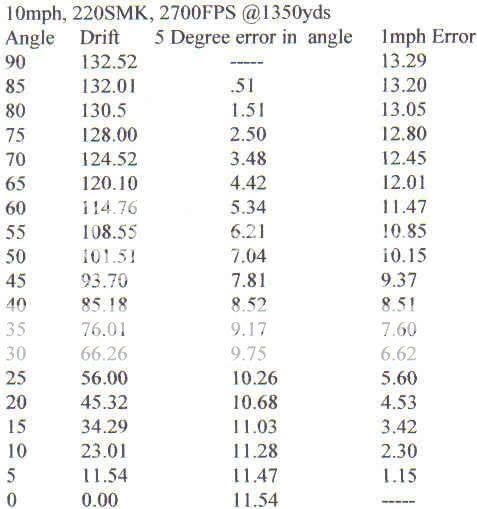I was setting around the house today, wishing the wind were a bit more stable so I could go shoot a few more groups before the rain sets in tomorrow, when I started thinking.
Ive been shooting at my portable target stand for a couple months now at 1350Yds. It is pointed almost due north out of nececcity, which also happens to be the direction the wind either blows from, or to here in Oklahoma 99.99% of the time. Needless to say, I shoot in a lot of those wonderful "fishtail" winds that switch back and forth from 10-15 degrees left to right, requiring you to switch compensation back and forth in both directions.
And then something dangerous began to happen, my mind began to wander...
Of fixed target ranges, you are pretty much at the mercy of the wind, but obviously you would position yourself for the optimal wind angle if you were hunting long range. My question is what would you consider to be the "optimal angle"
I wipped up a table for comparison in some of that free time today. It goes something like this... all values in IN.

The question is would you want to:
shoot into/out of the wind for minimal sensitivity to different windspeeds,
shoot in a full value crosswind for minimal variance in amount of drift due to varying angle of wind,
or something in between. Just looking at the book data, it would seem that the effects are most balanced for a 40 degree angle wind... at least at 10mph.
Lets hear it, how do you want your wind if you can pick?
Ive been shooting at my portable target stand for a couple months now at 1350Yds. It is pointed almost due north out of nececcity, which also happens to be the direction the wind either blows from, or to here in Oklahoma 99.99% of the time. Needless to say, I shoot in a lot of those wonderful "fishtail" winds that switch back and forth from 10-15 degrees left to right, requiring you to switch compensation back and forth in both directions.
And then something dangerous began to happen, my mind began to wander...
Of fixed target ranges, you are pretty much at the mercy of the wind, but obviously you would position yourself for the optimal wind angle if you were hunting long range. My question is what would you consider to be the "optimal angle"
I wipped up a table for comparison in some of that free time today. It goes something like this... all values in IN.

The question is would you want to:
shoot into/out of the wind for minimal sensitivity to different windspeeds,
shoot in a full value crosswind for minimal variance in amount of drift due to varying angle of wind,
or something in between. Just looking at the book data, it would seem that the effects are most balanced for a 40 degree angle wind... at least at 10mph.
Lets hear it, how do you want your wind if you can pick?
